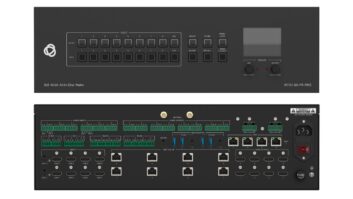
The first part of this feature on signal management looked at networked solutions, here we turn our attention to point-to-point configurations.
Lower cost, facilitation of control, scalability, simplicity of incorporating BYOD, flexibility: what’s not to like about networking? The advantages and benefits seem to be compelling – so much so that it’s hard to imagine any other way of getting devices to talk to each other.
Not so, it seems. Networking doesn’t have it all its own way.
“Point-to-point and what we call multipoint-to-multipoint are both useful configurations when talking about AV installations,” believes Micha Risling, chair of the HDBaseT Alliance’s Marketing Committee. “When it was first launched, HDBaseT supported point-to-point installations. With the launch of Spec 2.0 in 2013, HDBaseT can now support multipoint-to-multipoint configurations that open up a realm of possibilities for installers and integrators.”
“In some cases, there simply isn’t the need for a multipoint-to-multipoint set-up,” he continues. “Point-to-point is, by definition, a simpler, and as such cheaper, configuration. Any failure or error in a point-to-point network is also easier to pinpoint, as there are fewer elements in the installation.”
“Point-to-point provides extremely reliable signal transfer,” adds Brian Davies, AMX European technical director. “If the correct installation principles are followed, then a positive outcome can be assured. Network-based applications can be affected by external issues outside of the control of, and unforeseen by, the installer. These issues can be introduced by others long after the installation is complete and can lead to poor performance and result in negative views of the technology and/or installation company in the eyes of the end-user.”
“Currently, with the bandwidth of available video over network solutions being insufficient to pass the highest common resolutions without some form of compression, any application that requires 100% of the source signal information to be present at the display would be impossible to replace,” he continues. “This situation will become more apparent as the demands of bandwidth increase due to the adoption of more demanding video resolutions such as 4K and above.”
That’s the point to which Andy Fliss, director of marketing at TV One alluded – performance of video over the network – and it’s a recurring theme when the industry discusses the relative merits of point-to-point as compared with networking.
Patently inappropriate
Ooms provides a simple example of an environment in which networking is patently inappropriate.
“When the presenter is in the same room as the display, point-to-point uncompressed delivery is best because it introduces no latency and maintains the best quality,” he says. “Also, using streaming for every input/output will quickly overwhelm most existing infrastructure – just one uncompressed 4K signal is about 10 Gbps.”
Many presenters can, perhaps, live with a little latency and a reduction in quality – but, as Fliss points out, there are AV applications that can’t.
“Point-to-point is still the preferred approach for AV content transmissions today, due to its guaranteed and higher performance,” he thinks. “Point-to-point connections are more reliable, don’t suffer from network latency and don’t exhibit interrupted streams. They also don’t require video compression, which is considered a serious negative in many applications including medical, live events, military and engineering.”
“The future of AV lies intricately interwoven with IP,” says Tony Dowzall, president of Gefen. “However, we see examples in which networking may not be the ideal solution. A dedicated line is by definition more robust and reliable for its single purpose without the need for additional infrastructure to ensure its operation. Obviously, any venue in which a network is not already implemented is off limits. For example, in retail environments, we are experiencing networked source players providing content to videowalls in a point-to-point configuration. It simply depends on the environment.”
Thomas Tang, president of Apantac, makes some interesting points. “You have to bear in mind that not all point-to-point is created equal,” he maintains. “Some have distance limitations; some use compression algorithms; and some do not compress the signals. However, I believe point-to-point will always remain the simplest, most reliable and highest quality installation method.”
“When using networking/IP-based products, there are several potential issues,” he carries on. “First: the signal is usually compressed, whether lossless or not, and will contribute to more latency. Second: a different set of expertise is required to configure network switches and, often, installers that are IT-savvy demand higher salaries. A third point to remember is that security may be a concern in some organisations. And lastly, there are potential headaches for an integrator if different departments within an organisation need to be involved at the customer site – the age-old story of video versus IT departments.”
Multipoint-to-multipoint
But, as Risling explains, point-to-point need not only be about one device communicating with one other device.
“In any set-up where you have many sources and/or displays, multipoint-to-multipoint brings several advantages over a point-to-point configuration,” he declares. “HDBaseT Spec 2.0 allows for daisy-chaining, which means that the same source can be fed to several displays daisy-chained 100m apart from each other. There’s no need to duplicate sources, or to locate them next to each display. This is particularly useful for digital signage.”
“And,” he continues, “HDBaseT Spec 2.0 also allows for multistreaming, which means that the same or different sources can be fed to different displays, once all are connected to a switch or matrix. Again, there is no need to place the sources next to each display, or duplicate them. This is particularly useful for corporate usage, residential set-ups, or videowalls. In any set-up of several displays and several sources, this can save both equipment and labour expenses when compared with setting up several point-to-point installations. In addition, control and management are centralised, saving maintenance and management expenses.”
www.amx.com
www.apantac.com
www.gefen.com
www.hdbaset.org
www.tvone.com







